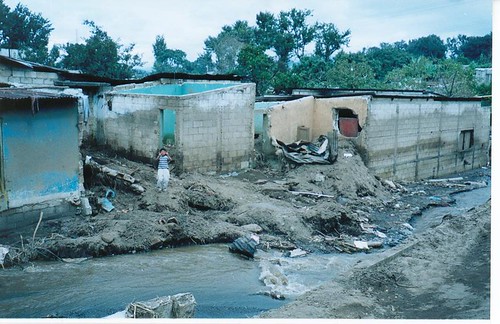more on the flooding in Guatemala
This article was written by Megan Hyslop, who was working at Maya Pedal in San Andrés Itzapa at the time of the Hurricane Stan. She is helping out with the transfer of $720 of the money folks sent to me for redistribution to people displaced by the hurricane. As the article relates, there was very good community support for the victims in the immediate aftermath of the hurricane, and this money will be going towards helping them rebuild for the longer term. I will continue posting what I know about what is happening.
=======================Rebuilding in San Andres Itzapa - by Megan Hyslop
The rain began the night of Sunday, October 1st and didn't stop until Thursday morning. Today is Saturday, October 8th. The town is San Andres Itzapa, Guatemala, the land of friendship and the guaque chile, as its entrance sign proclaims, and one of the many communities afflicted by the recent floods and mudslides brought on by Storm Stan in the Gulf of Mexico.
I came to Guatemala a month ago as a CIDA intern with the GAIA project. My original assignment was to work with Maya Pedal, a local NGO that builds pedal powered machines such as corn grinders, from recycled bikes. However, this week bikes take a back seat to more pressing needs as all of the staff at Maya Pedal are out helping the community. Samara, a Maya Pedal volunteer, and I visited one of the shelters in town Wednesday night. Since then, our role has evolved to include serving hot atol, a warm corn drink, to the people in the shelter and playing with the children now living there. Approximately fifty indigenous families lost their homes and land to a swollen river that only now has begun to recede. The community support has been incredible. Bags of used clothing, beans, corn flour, toilet paper, and diapers are piled along one wall of the shelter, in this case, a public hall/gym. Hardworking volunteer women cook meals for the group. Each morning, women living in the shelter enter the makeshift kitchen to tortear, or slap corn flour dough between their hands for the day's tortillas. An equally devoted group of men bring drums of water to the shelter daily, as ninety percent of the pipes in town broke during the storm. Others shoulder picks and shovels and walk up to the mountains to work on the momentous task of fixing the water system, a project that the town leaders estimate will take five months. There has been a loss of corn and bean crops, the staple foods here in Guatemala. In a sense, San Andres is lucky. There was no loss of life and the town remains uncovered by mud. The roads into the town are unblocked by dirt and uprooted trees. It is worse, the newspapers tell us, in other communities. As is often the case, the people most affected by this disaster are those with scarce economic resources.
There are approximately one hundred children staying in the shelter. In the mornings or afternoons, Samara and I, with the help of the older girls, take a small group down the cobbled streets to the basketball and soccer courts beside the town square for games and fresh air. The view of the green hills surrounding the town and the sunshine is welcome after the stuffy air of the albergue, or shelter. The boys invariably start a soccer scrimmage; the girls play their own match or other group games. Pato, pato, ganso (duck duck goose) has become a new favourite; the children in exchange have taught us "In the patio of my house", a circle game that involves a lot of crouching and yelling "CHOCOLATE!" in the ears of the child in the center of the circle. My strange name, my country of origin, and my nose ring also provide endless entertainment. The children cling to our arms but seem to be facing their predicament with bravery. On the one hand, it is inspiring to see the webs of support woven by the people of San Andres Itzapa and the rest of the country. On the other hand, it's hard to look at the people in the shelter and wonder where and how they will rebuild their lives.
It is raining again, but this time only an afternoon shower typical of the wet season in San Andres. People stop on the street and take cover under the eaves of the blue and green cement homes and store fronts. Rain on a tin roof is thunderous. With any luck, this time the water water will stop before dark.
written by Megan Hyslop, from Maya Pedal


0 Comments:
Post a Comment
<< Home